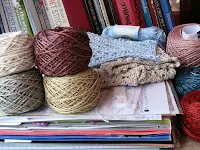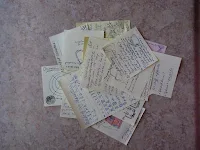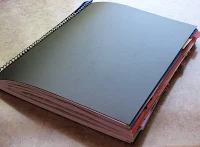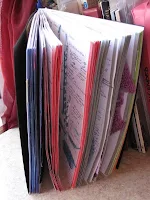
I revised and expanded this blog post in 2018. The images are updated too, so scroll down to view these before you fast forward nine years!
-:------------------------------------------:-
The release of my newest design, the Tokyo Jacket, makes this a good time to blog some tips I've learned about crocheting the taller stitches, such as Trebles, Double Trebles, Triple Trebles, Quad-Trebles (to name a few; these are all in US terminology).
If you already know how to do the Double Crochet stitch, it's easy to understand how to make the taller ones. To make a Triple Treble (Trtr), for example, you yarn over (wrap the yarn around your crochet hook) four times instead of once for a Double Crochet. You work the loops off of the hook in pairs just like you do to make a Double Crochet. The only difference is that you have more pairs of loops to work off.
In actual practice, one crocheter's Trtr can come out looking very different from another's. Sometimes the Trtr's come out noticeably shorter or taller, sometimes they look lumpy or stringy and thin. A common problem is when they look loose and loopy at the tops of the stitches.
Here's what I've learned so far.
If you have other tips for crocheting the really tall stitches, I hope you'll add them in the comments section:Tall fancy stitches love to be blocked.
This probably sounds about as fresh and exciting as "take time to check your gauge" but would you believe that blocking can seem like a spiritual experience? The transformation is so worth it.
Pull your loop up higher.
I first learned this about Double Crochets from Pauline Turner in her Crocheted Lace book (Martingale, 2003). Pauline explained to me why even experienced crocheters can have trouble getting a doily to lie flat: their stitch heights might vary from the designer's.
I can avoid loosey-goosey tops of tall stitches two ways.
1. Firm up the loops on the hook.
First, after I yarn over 4 times for a Trtr, I tug on the yarn to firm up the wraps around the hook before commencing the stitch.2. Use more yarn from the hook.
Then, while working the loops off of my hook in pairs, I pull up a bit on the loops to draw some of my yarn from the wraps around the hook. Not all of the yarn for completing the stitch is coming from the ball of yarn, only what's needed after I take up any slack from the wraps around the hook. This way the stitches comes out uniformly neat and orderly looking. Basically, I crochet the really tall stitches like I'm on a budget.
 Photo on left was taken before blocking, the other was taken during blocking.
Photo on left was taken before blocking, the other was taken during blocking.
I simply sprayed it with cool water, gently smoothed out the fabric on a towel, and let air dry. (Close ups: here and here.)
I pull up a bit on the loops because it adds a fashionable drape to the fabric and gives the really tall stitches a limber, elegant look instead of chunky.
Sometimes the yarn matters.
A right-handed crocheter wraps the yarn around the hook in a counter-clockwise direction. For a tall stitch, this repeated wrapping either untwists a yarn, or adds more twist--depending on whether the yarn starts out with a clockwise or counterclockwise twist (a.k.a. "S-twist" or "Z-twist"). |
| A 2-ply loosely S-twisted yarn was used for these Trtr fans. Can you see the plies separating within the stitches? (Click here for close up) |
Sometimes it's more noticeable than other times; it can make the tall stitches look stringy or uneven because it's more difficult to work the loops off the hook quickly without splitting the plies of yarn. It also depends on the gauge the crocheter's using, and on how the crocheter controls the loosey-goosey loops (see above).
I'm a right-handed crocheter, and the yarn I used for the Tokyo Jacket is Z-twisted; so my hook was flying while I made a gazillion Trtr stitches for the design and I like how even they look.
Crochet's lacy beauty really shines through with the tall stitches, doesn't it? I fall in love with crochet all over again when I use them.







































